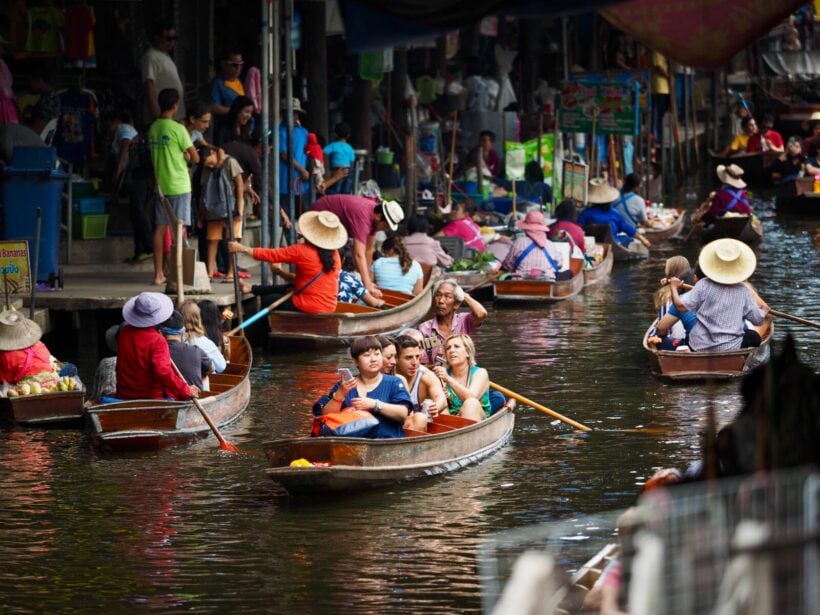Travel Guide: What are Thailand’s 3 seasons and when to visit in 2022?

Thailand is the most visited country in Southeast Asia. Its beautiful beaches and lush mountain jungles, in contrast to the colourful contradiction of Bangkok (where modern concrete skyscrapers are sitting next to traditional temples), are all popular destinations, not to mention the many delectable dishes and street foods that are famous worldwide.
To the distant eye, Thailand might seem like a country with constant topical heat throughout the year. While that might be true for most locations, in reality the weather is much more nuanced and changes during three quite distinct seasons. So when is the best time to visit the Land of Smiles? Keep reading to find out!
To begin with, Thailand is located in the Inter Tropical Convergence Zone and has three seasons: the dry and ‘cool’ season is, generally, from November to February; the oven-like weather of the hot season spans from March to June; and the humid, rainy season lasts from July to October (there are regional exceptions to these general rules).
Editor’s note: Please check the latest travel requirements and restrictions for Thailand before making any further plans. Read more about Thailand’s Test & Go travel program here.
Hot Season: March to June
The temperature starts to rise as soon as February, but won’t reach the peak until April. It will stay hot until late June and possibly July, until it starts to rain. Temperatures tend to hover in the mid-30s and can even breach a blistering 40 degrees Celsius in some parts of the country. This is the best time to visit the beaches, where you can enjoy the sunny weather and walk around without worrying about a sudden rainstorm.
The popular Songkran Festival takes place from April 13-15, when you can participate in public water fights. Just make sure to arm yourself with plenty of water balloons and squirt guns, and abide by the rules of new normal festival etiquette. Songkran, the Thai new year, is the festival to celebrate the arrival of the annual monsoon.
Monsoon Season: July to November
The rainy season in Thailand is like a bad cocktail: the two don’t mix well. This is when boiling temperatures meet the monsoon rains. The humidity can be quite high.
The rainbow in the raincloud is that the rainy season is also traditionally the low season for tourism in Thailand. This is the quietest time to visit the country, while most tourists prepare their beach bodies for the return of consistently sunny weather with no clouds in sight.
On the upside, this a great opportunity for anyone who wants to save some money or doesn’t want to travel around with too many other tourists. Just make sure to bring an umbrella or pack your bag with a 20 baht plastic poncho from 7-Eleven. But, usually, the rain is heavy, but brief. And it’s always warm.
- Read more about Thailand’s monsoon season here
So what causes Thailand’s rainy season? As the southwest monsoon sweeps up out of the Indian Ocean, it carries moist air and heads toward the northeast, where it is sucked into a void replacing the rising warm air over the Asian continent warmed by the summer sun. The monsoon also coincides with Thailand’s location in the Southeast Asian tropical rain belt.
- Read our Top 10 ways to cope with Thailand’s humidity
- Read our 10 things to do in Phuket during the wet season
Dry & ‘Cool’ Season: December to February
The dry season is the most recommended time for travellers to visit and is regarded as the high season for tourism. Yes, it’s still sunny, generally clear and can have some ‘cooler’ mornings (if you regard 20C as ‘cool). The wind is more of a cool breeze than a hot blow drier, especially in the early mornings and evenings.
The weather seems to find a perfect balance, unlike the other seasons when it’s either too humid or too hot. If you’re going to visit north, like in Chiang Mai, you’ll get to experience the ‘chilly’ weather in Thailand. Thais love to go there for camping during the later days of December to experience the drop in temperature, and dust off their jackets and sweaters.
When is the best time to visit?
So there you have it, a breakdown of Thailand’s three seasons. Although the heat doesn’t go away, it does change throughout the year. If you don’t like the rain then it’s best to avoid the monsoon season, especially during the wettest months of August and September (but some of us love the refreshing interlude… it never lasts too long).
As for the hottest months, you should avoid travelling to Thailand in April and May. Perhaps the best reason to visit during this time is to experience the clear blue skies and splendid sunsets on the beach.
For the average tourist, and those who can wait until later in the year, we recommend visiting from November to February because of the relatively cool and dry weather.
What’s your take? Have you experienced the seasons in Thailand? Which season do you find most enjoyable and why? Let us know your thoughts in the Thaiger Talk comments section down below!
Latest Thailand News
Follow The Thaiger on Google News:


























